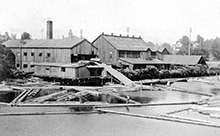Victoria Harbour is part of the traditional territory used and inhabited for thousands of years by First Nations. The descendants of the main groups of people that lived in this area are known today as the Esquimalt and Songhees Nations. Before European settlement, extended family groups lived in various locations around Victoria, including James Bay, the Inner Harbour, McNeil Bay, Cadboro Bay and Discovery Island. The historic “park-like” land around Victoria Harbour – Garry oak trees with wildflower meadows – was valued created and maintained through deliberate land management by First Nations. for camas bulbs, a major food and trading staple and Pacific willow, used for making fishing nets and lines.
In 1843, a crew of Hudson’s Bay Company men, led by James Douglas and assisted by Songhees people, built a trading post in a clearing among Garry oaks where Bastion Square stands today. The track that ran through the centre of the trading post later became Fort Street. The original purpose of the post was to serve as a trade depot for whaling ships, and to supply Russian fur trading expeditions in Alaska. The post also helped to solidify British claims to the west coast.
In 1858, tens of thousands of gold seekers came through Victoria on their way to the Fraser River. Following that and for the next 40 years, Victoria was the most active port north of San Francisco.
 Over the course of its history, industries around Victoria Harbour have included ship building and repair, sawmilling and log booming, machine manufacturing, coal gasification, paint manufacturing, a tannery, a propane tank farm, a concrete batch plant and an asphalt plant. Pollution from these industries, along with sewage contamination, substances disposed of in storm drains, and chemicals washed off impervious surfaces, has caused serious degradation of the marine environment in the harbour.
Over the course of its history, industries around Victoria Harbour have included ship building and repair, sawmilling and log booming, machine manufacturing, coal gasification, paint manufacturing, a tannery, a propane tank farm, a concrete batch plant and an asphalt plant. Pollution from these industries, along with sewage contamination, substances disposed of in storm drains, and chemicals washed off impervious surfaces, has caused serious degradation of the marine environment in the harbour.
Some industrial areas in the harbour were filled in with rock, rubble and sometimes contaminated materials, in order to create more land along the waterfront. Industrial practices and infilling resulted in surrounding lands and marine sediments which were full of toxic contaminants. Two of these sites are Rock Bay and Peter Pollen Park. Extensive remediation projects have taken place at these sites to address the contaminated soils and/or marine sediments.
Residential properties are gradually being built on sites previously used by industry, such as the Railyards, Dockside Green and Selkirk Waterfront developments.
In 2012 the City of Victoria completed a rainwater management project at Fisherman’s Wharf Park in the James Bay neighbourhood. The refurbished park includes Victoria’s largest rain garden (352m2) which receives and treats runoff from 14,250m2 of impervious surfaces in the James Bay area. The park also features a stone retaining wall that marks the original location of the harbour shoreline.